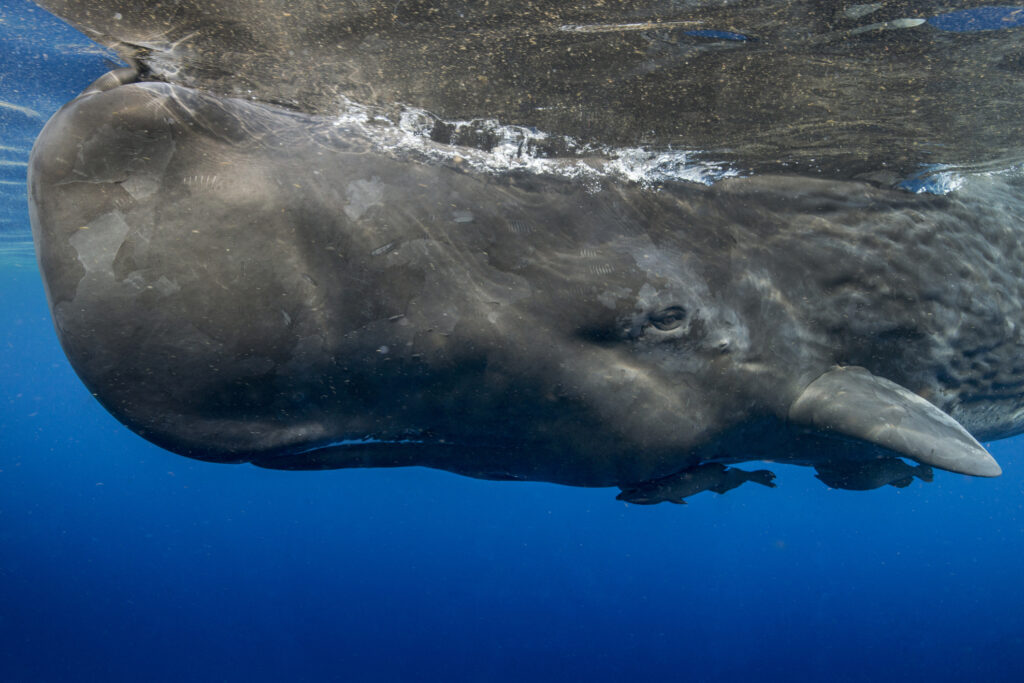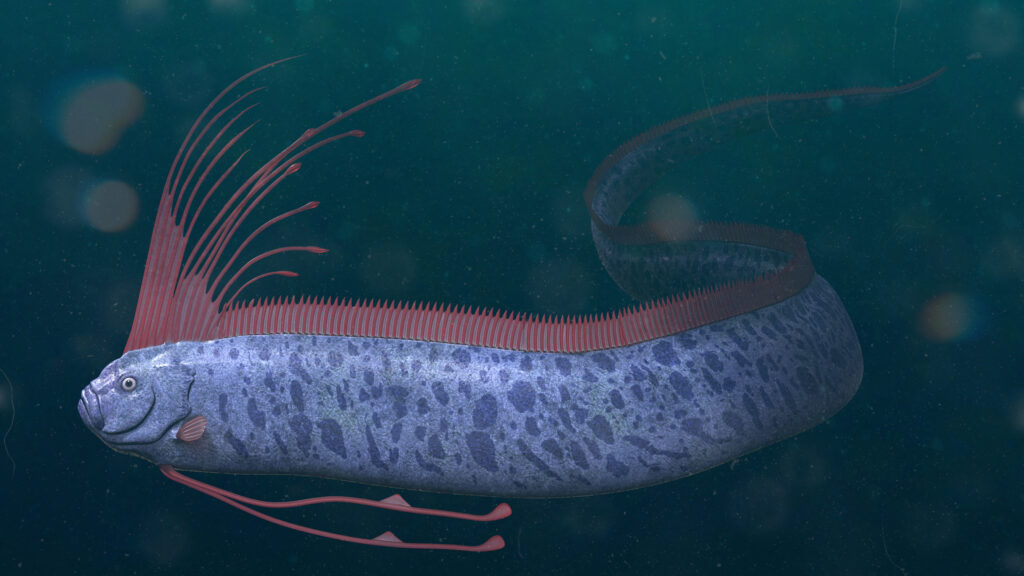The diversity of creatures found in our oceans is staggering. In fact, the oceans actually contain 99% of all the living space on Earth by volume, so it should be no surprise that the world’s biggest lifeforms reside underwater.
In this blog, we’ll take a closer look at the size and diversity of marine life, uncovering the habitats, diets and other fascinating facts about these incredible creatures.
The biggest creatures living in the ocean
So, what are some of the biggest creatures that live in the ocean, and what do we know about them? From the blue whale to the colossal squid, get ready to learn something new about these rather large marine animals.
Blue whale
The blue whale (Balaenoptera musculus) actually evolved from land mammals around 50 million years ago. They developed more streamlined bodies and baleen plates, enabling long-distance swimming and filter feeding. Known as a baleen whale, they have fringed plates in their upper jaw instead of teeth.
Typical habitat of a blue whale
Blue whales can be found across open oceans throughout the world, except the Arctic. They typically migrate between colder, krill-rich feeding grounds and warmer breeding areas. Some of the most prolific areas include the Northeast Pacific and the North Atlantic.
Blue whale appearance
The blue whale is the largest animal in the world, and not just in the ocean! They can measure as long as 30 metres and could weigh as much as 180 tonnes. They have long, slender blue-grey bodies, mottled with lighter spots, and a small dorsal fin.
Interestingly, blue whales have a heart the size of a small car, and they are louder than a jet engine, with their calls reaching around 188 decibels.
Diet
Blue whales feed almost exclusively on krill. They lunge through swarms of krill, taking in more food in one mouthful than any other animal. A blue whale can eat as much as 4 tonnes of krill in one day. That’s about as heavy as a hippopotamus!
Blue whale conservation status
Due to commercial whaling, the blue whale is listed as endangered by the IUCN, although populations are now slowly recovering. They’re protected under the Marine Mammal Protection Act, which makes it illegal to kill or injure these animals.

Lion’s mane jellyfish
The lion’s mane jellyfish (Cyanea capillata) is a mesmerising creature with long, stinging tentacles. It’s known to be the biggest jellyfish out there, and typically lives around 12 months.
Habitat of a lion’s mane jellyfish
Lion’s mane jellyfish are usually found in colder waters, such as the Arctic, northern Atlantic and northern Pacific oceans. They can sometimes be seen drifting near the water’s surface and can even be found off the coast of the British Isles.
Lion’s mane jellyfish appearance
This species of jellyfish has a very distinctive appearance, as you can guess from its name. Reddy-brown or yellow in colour, they have flowing, hair-like tentacles that resemble a lion’s mane. These tentacles can extend over 36 metres and are packed with stinging cells.
Diet
The lion’s mane jellyfish will use its tentacles to sting and paralyse its prey, which can include zooplankton, small fish like fish larvae, crustaceans like shrimp and even other jellyfish such as moon jellyfish.
Lion’s mane jellyfish conservation status
Lion’s mane jellyfish are not thought to be at risk, but it’s important to preserve this by avoiding overfishing and considering the impact of climate change on this species. For instance, rising seawater temperature could be a significant factor.
Giant Pacific octopus
The giant Pacific octopus (Enteroctopus dofleini) truly lives up to its name, being the largest octopus species in the world. They have evolved with the ability to camouflage and have flexible bodies to navigate coral reefs. They’re an incredibly intelligent species, capable of tasks like solving puzzles and even opening jars.
Habitat of a giant Pacific octopus
This species is found across the coastal waters of the Northern Pacific, often inhabiting rocky reefs and ocean floors. They’re known as benthic, which means they live at the bottom of the ocean, and typically live in dens formed by rocks and caves, especially when it comes to laying eggs.
Giant Pacific octopus appearance
Giant Pacific octopuses are typically reddish-brown, but they can utilise special pigment cells to change their skin colour and texture. They have large, bulbous heads and 8 arms equipped with suction cups.
Their arms usually span up to 5 metres, and they weigh up to 15kg. The largest giant Pacific octopus was recorded as weighing 181 kg with a 7.6m arm span!
Diet
Giant Pacific octopus are nocturnal hunters, catching prey with their arms before using a sharp beak to eat. Their diet consists mostly of crabs, clams, squid and lobsters as well as other fish.
Giant Pacific octopus conservation status
The giant Pacific octopus isn’t endangered, but they do face some common threats, such as effects from overfishing and habitat degradation. Warming temperatures in particular could impact their population.

Sperm whale
The sperm whale (Physeter macrocephalus) is the deepest diving mammal, able to dive down over 2,000 metres below sea level. They have evolved to develop a large organ in their heads, which helps with deep dives and sound-based hunting in the darker parts of the deep ocean. Sperm whales also use loud clicks, known as echolocation, for communicating with others.
Habitat of a sperm whale
Sperm whales prefer deep ocean habitats around continental shelves and deep-sea canyons, although they can be found worldwide.
Sperm whale appearance
This species has a large, block-shaped head that covers one-third of its body length, as well as wrinkled grey skin and a single blowhole on the left side. Male sperm whales can grow up to 20 metres in length and weigh up to 57 tonnes.
Diet
Sperm whales primarily survive on a diet of squid, including the giant squid. They have a fairly big appetite, consuming around 0.9 tonnes each day – that’s equivalent to the weight of a small car!
Sperm whale conservation status
Sperm whales were historically hunted for sperm oil, which has left populations vulnerable. Protecting their habitats and reducing bycatch can help protect these large whales.
Basking shark
The basking shark (Cetorhinus maximus) is a typically slow-moving surface-dwelling shark species with a huge mouth and gill rakers, which have evolved for efficient plankton filter feeding.
Habitat of a basking shark
Preferring temperate ocean climates in coastal and continental shelf waters, basking sharks can often be seen near the UK coasts during summer.
Basking shark appearance
Basking sharks are unmistakable in their appearance, with their large gaping mouths, grey-brown bodies and prominent gill slits. But the most telling sign that it’s a basking shark is their size. As the second-largest fish in the ocean, they grow up to 12 metres in length.
Diet
Basking sharks use their large, gaping mouths to filter feed vast amounts of plankton by just leaving their mouths open.
Basking shark conservation status
Overfishing and slow reproduction have led to basking sharks being classified as endangered. By improving knowledge of this UK native species, though, we can help protect it for generations to come.
Whale shark
Whale sharks (Rhincodon typus) might be large, but, in reality, they’re gentle giants of the ocean. Living over 70 years and having been around for an estimated 50 million years, these sharks have seen lots of changes in the ocean, which has led to evolutions such as their wide, flat heads and large mouths.
Habitat of a whale shark
The whale shark inhabits tropical and warm temperate oceans around the world. They mostly prefer open waters, though they can also be spotted near the shore.
Whale shark appearance
Whale sharks are officially the largest fish species known to exist in our oceans today, growing up to nearly 19 metres and reaching between 15 and 20 tonnes. They have grey bodies covered with distinctive white spots and stripes, along with large mouths stretching up to 1.5 metres wide.
Diet
Like the basking shark, whale sharks filter feed on plankton, krill and small fish species. They can filter thousands of litres of ocean water per hour.
Whale shark conservation status
Unfortunately, whale sharks are classified as endangered due to fishing, bycatch and collisions with fishing boats and ocean cruise liners.

Oarfish
Oarfish (Regalecus glesne) are believed to have inspired many sea serpent myths, with their slender, ribbon-like bodies that help them glide through deep waters.
Habitat of an oarfish
Oarfish are rarely spotted near the ocean’s surface. They mostly prefer deep ocean waters at depths between 200 and 1,000 metres worldwide.
Oarfish appearance
The oarfish can grow up to 11 metres, making it the longest bony fish in the ocean. Aside from their large size, their appearance is also distinctive thanks to their silvery, snake-like bodies with red crest-like dorsal fins along their backs.
Diet
Oarfish have a varied diet, feeding on plankton, small crustaceans and other tiny fish living in the deep ocean waters.
Oarfish conservation status
While oarfish aren’t classified as endangered, little is known about their populations because of their deep-sea habitats.
Colossal squid
Little is known about the colossal squid (Mesonychoteuthis hamiltoni) since only a few specimens have been studied. What we do know about these deep-sea mysteries is that they’ve developed massive eyes, which help with low-light vision, alongside tentacles with swivelling hooks for capturing prey effectively.
Habitat of a colossal squid
The colossal squid mostly inhabits the deep, cold Southern Ocean region near Antarctica, having adapted to the harsh conditions here.
Colossal squid appearance
Estimated to grow up to 14 metres long and up to 495kg; this species really lives up to its colossal name. It has a large mantle, relatively small arms, huge eyes and bioluminescent organs like many other deep-sea creatures.
Diet
As natural predators of many fish and squid species, the colossal squid hooks other marine creatures with adapted tentacles to secure its prey.
Colossal squid conservation status
The colossal squid is a rarity, so with a lack of data on population sizes and any rises or falls, scientists are unsure of its conservation status.
See a vast range of ocean life at Bristol Aquarium
Our team of aquarists are dedicated to the conservation of all life in our oceans and beyond – whether it’s animal husbandry or raising awareness for the prevention of marine litter, we aim to give back to and protect our environment as much as we can. To find more information on the conservation work we do, check out all our successful captive breeding stories.
But don’t stop there, you can do your part too! From our school and club visits for different ages to daily talks and feeds, you can dive in and find out all about our vast range of ocean life on a visit to Bristol Aquarium!
